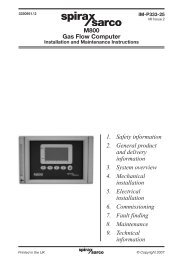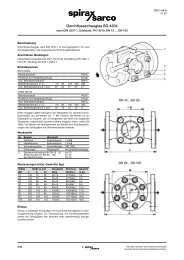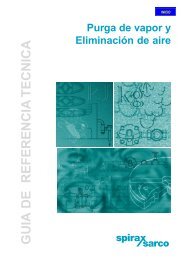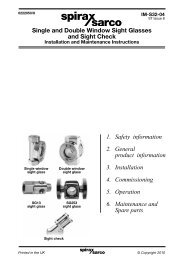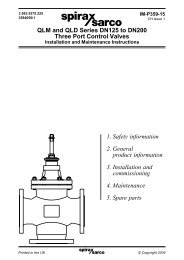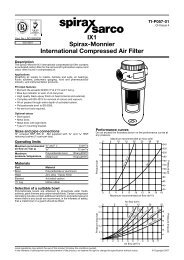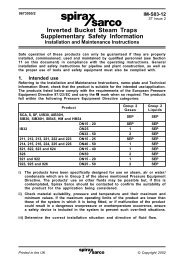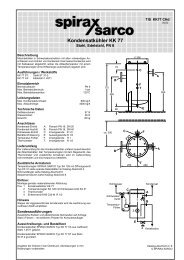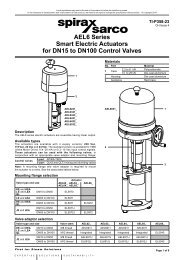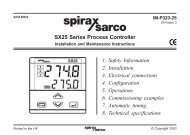2000 Hook-up Book - Spirax Sarco
2000 Hook-up Book - Spirax Sarco
2000 Hook-up Book - Spirax Sarco
You also want an ePaper? Increase the reach of your titles
YUMPU automatically turns print PDFs into web optimized ePapers that Google loves.
SYSTEM DESIGN<br />
24<br />
How to Size Temperature and Pressure Control Valves<br />
Calculating Condensate Loads<br />
When the normal condensate load is not known, the load can be<br />
approximately determined by calculations using the following formula.<br />
General Usage Formulae<br />
Heating water with steam (Exchangers)*<br />
GPM x (1.1) x Temperature Rise °F<br />
lb/h Condensate =<br />
2<br />
Heating fuel oil with steam<br />
GPM x (1.1) x Temperature Rise °F<br />
lb/h Condensate =<br />
4<br />
Heating air with steam coils<br />
CFM x Temperature Rise °F<br />
lb/h Condensate =<br />
800<br />
Steam Radiation<br />
Sq. Ft. EDR<br />
lb/h Condensate =<br />
4<br />
*Delete the (1.1) factor when steam is injected directly into water<br />
Specialized Applications<br />
Sterilizers, Autoclaves,<br />
Retorts Heating Solid Material<br />
lb/h Condensate =<br />
W x Cp x ∆T<br />
L x t<br />
W = Weight of material—lbs.<br />
Cp = Specific heat of the material<br />
(∆)T = Temperature rise of the material °F<br />
L = Latent heat of steam Btu/lb<br />
t = Time in hours<br />
Heating Liquids in Steam Jacketed<br />
Kettles and Steam Heated Tanks<br />
lb/h Condensate =<br />
G x s.g. x Cp x (∆)T x 8.3<br />
L x t<br />
G = Gallons of liquid to be heated<br />
s.g. = Specific gravity of the liquid<br />
Cp = Specific heat of the liquid<br />
(∆)T = Temperature rise of the liquid °F<br />
L = Latent heat of the steam Btu/lb<br />
t = Time in hours<br />
Heating Air with Steam;<br />
Pipe Coils and Radiation<br />
A x U x (∆)T<br />
lb/h Condensate =<br />
L<br />
A = Area of the heating surface in square feet<br />
U = Heat transfer coefficient (2 for free convection)<br />
(∆)T = Steam temperature minus the air temperature °F<br />
L = Latent heat of the steam Btu/lb<br />
Valve Sizing For Steam<br />
Satisfactory control of steam flow to give<br />
required pressures in steam lines or<br />
steam spaces, or required temperatures<br />
in heated fluids, depends greatly on<br />
selecting the most appropriate size of<br />
valve for the application.<br />
An oversized valve tends to hunt, with<br />
the controlled value (pressure or temperature),<br />
oscillating on either side of the<br />
desired control point. It will always seek to<br />
operate with the valve disc nearer to the<br />
seat than a smaller valve which has to be<br />
further open to pass the required flow.<br />
Operation with the disc near to the seat<br />
increases the likelihood that any droplets<br />
of water in the steam s<strong>up</strong>ply will give rise<br />
to wiredrawing. An undersized valve will<br />
simply unable to meet peak load requirements,<br />
start<strong>up</strong> times will be extended and<br />
the steam-using equipment will be unable<br />
to provide the required output.<br />
A valve size should not be determined<br />
by the size of the piping into<br />
which it is to be fitted. A pressure drop<br />
through a steam valve seat of even a few<br />
psi means that the steam moves through<br />
the seat at high velocity. Valve discs and<br />
seats are usually hardened materials to<br />
withstand such conditions. The velocities<br />
acceptable in the piping are much lower<br />
if erosion of the pipes themselves is to<br />
be avoided. Equally, the pressure drop of<br />
a few psi through the valve would imply<br />
a much greater pressure drop along a<br />
length of pipe if the same velocity were<br />
maintained, and usually insufficient<br />
pressure would be left for the steamusing<br />
equipment to be able to meet the<br />
load.<br />
Steam valves should be selected on<br />
the basis of the required steam flow<br />
capacity (lb/h) needed to pass, the inlet<br />
pressure of the steam s<strong>up</strong>ply at the<br />
valve, and the pressure drop which can<br />
be allowed across the valve. In most<br />
cases, proper sizing will lead to the use<br />
of valves which are smaller than the<br />
pipework on either side.<br />
Steam Jacketed Dryers<br />
1000 (Wi - Wf) + (Wi x ∆T)<br />
lb/h Condensate =<br />
L<br />
Wi = Initial weight of the material—lb/h<br />
Wf = Final weight of the material—lb/h<br />
(∆)T = Temperature rise of the material °F<br />
L = Latent heat of steam Btu/lb<br />
Note: The condensate load to heat the equipment must be added<br />
to the condensate load for heating the material. Use same formula.



